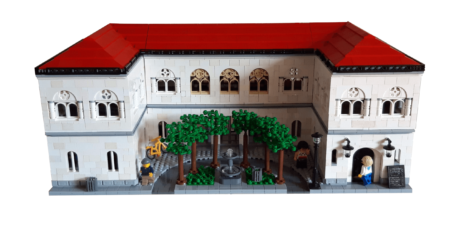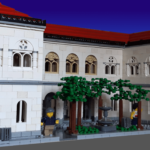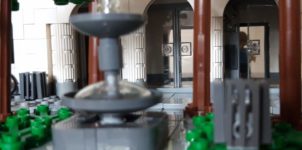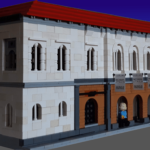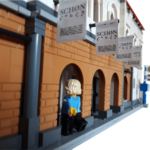University of Munich
Stylized model of a neoclassical building
Munich’s Ludwig Maximilians University (LMU) is Germany’s biggest campus university, and also Pieter’s and Ingo’s alma mater. While not used primarily as a classroom building anymore, the well-known neoclassical structure is undoubtedly the reputed university’s representative center. The model has been created in minifigure scale and has been designed to reflect the building’s unique character and features without having to do an exact scale reproduction – for this would have resulted in a model at least 2 meters wide. The modelling approach thus focused on finding ways to render the original’s unique details in Lego®, and at the same time reducing the number of repeating elements like windows and colonnades without compromising the overall look. Additionally, to make the model compatible with the popular Lego Creator “cafe corner” modular buildings, the model would have to fit onto two small baseplates (2 x 32 studs, equalling 2 x 26cms / 10.1″).
While not exactly roomy, this space now includes all the building’s defining features, and more. The basic layout is that of a wide U whose arms enclose the famous semicircle courtyard, which is replete with trees, lawn, and the indispensable fountain. Both the ledges between the stories and the Romanesque round-arch windows, in keeping with neoclassical standards, feature some detailwork without smothering the generally sober yet sublime arrangement. Upon closer examination, the original reveals that its marble appearance owes not to yellowing, darkening or weathering effects, but has been intentionally created by painting the facade blocks in varying very light pastel colors in an alternating, speckling pattern. The result adds some very delicate texture to the building while maintaining its chaste classical character. This effect had to be translated into Lego. After some pondering and experimenting, the approach which would best do this turned out to be a surprisingly simple one: along with immaculate new elements, the building walls are interspersed with used pieces with differing degrees of yellowing, darkening and tear marks. Proven with a neoclassical building, this technique will find its way into reproductions of other historical and ancient buildings.
The model also includes detailed interior work. Finely crafted staircases connect the ground and first floor on each end, their atriums housing statues and sculptures. There is a cafe and a locker room, and if you are interested in archeology, you may want to drop into Dr. Jones’s class in the main auditorium. For those viewers who like to linger over a model and to discover more details on the second and third look, some specialties have been included as well. The ledge between the two stories, instead of just one plate jutting out, was to recess in a gradated, tiered fashion – in the space of a half stud, or 4mm (1/6″). The solution may be blasphemy for the more technically oriented Lego builder, but it does its job like no other trick: a vintage two-core lighting cable was fastened and tightened along the building front. I leave the details to your imagination! And finally, the university’s court would only be complete if it included a replica of the famous Scholl siblings memorial. A special sticker has been created to render the in-ground stone leaflets.
Just give us a call, or send us an e-mail with your initial questions. Feel free as well to use our contact form. We are looking forward to discussing your ideas!
Our specialty is exactly this: delivering unique premium Lego models of your favorite personal, historical or contemporary building. Architectural details and almost any kind of material and texture like glass, stone, wood, brick, or metal, can be rendered in Lego® in a wide range of colors. At any scale, a professional Lego model will captivate audiences anywhere.
Let us know which building or structure you would like to present to your audience or your customers.

